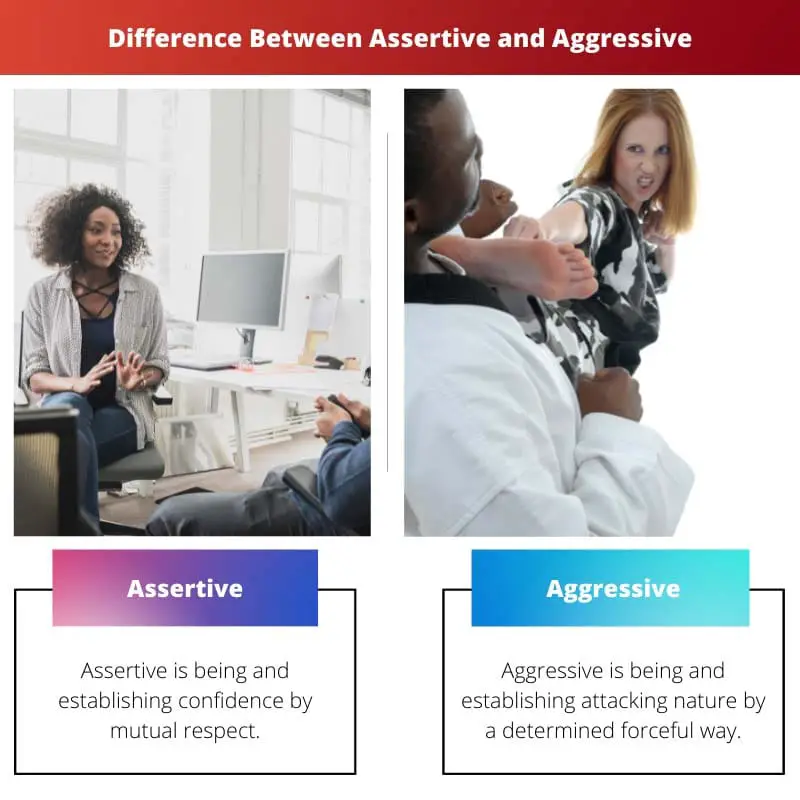Being assertive involves expressing your thoughts, feelings. It needs with confidence and respect for others, while aggression entails forceful and hostile behavior intended to dominate or control, disregarding the feelings of others. The key distinction lies in the balance between self-expression and consideration for others in assertiveness, as opposed to aggression’s dominating and potentially harmful nature.
Key Takeaways
- Assertive behavior is characterized by expressing one’s feelings, opinions, or needs in a confident, respectful, and honest manner without violating the rights of others.
- Aggressive behavior involves forcefully expressing one’s needs, opinions, or feelings in a way that disregards or disrespects the rights and feelings of others.
- The main distinction between assertive and aggressive behavior is the approach and intent, with assertiveness being respectful and considerate of others. At the same time, aggression involves forceful, disrespectful actions that can harm relationships and communication.
Assertive vs Aggressive
Assertiveness involves clearly and confidently expressing one’s needs and opinions while also respecting the rights of others. Aggressive communication involves imposing one’s needs and opinions on others without considering their feelings or rights. Assertiveness is a healthy and effective communication method, while aggression is seen as unfavourable and can lead to conflicts and hurt feelings.

Comparison Table
| Feature | Assertive | Aggressive |
|---|---|---|
| Goal | Express needs and desires while respecting others’ rights | Dominate or control others, through intimidation |
| Communication | Direct, clear, and respectful | Hostile, blaming, and accusatory |
| Body language | Open posture, eye contact, calm voice | Tense posture, clenched fists, loud or angry voice |
| Impact on others | Encourages open communication and collaboration | Creates fear, resentment, and resistance |
| Outcomes | Win-win solutions or compromise | One-sided victory, with damaged relationships |
| Examples | “I need to finish this report by tomorrow. Can we reschedule our meeting for later?” | “You always mess everything up! Why can’t you ever do anything right?” |
What is Assertive?
Assertiveness is a communication style characterized by expressing one’s thoughts, feelings, and needs openly, honestly, and respectfully, while also respecting the rights and opinions of others. An assertive individual communicates confidently, maintains a firm stance on their beliefs, and effectively navigates interpersonal interactions without being overly passive or aggressive.
Assertive communication involves:
1. Clear Expression
Assertive individuals clearly articulate their thoughts, opinions, and needs. They straightforwardly express themselves, avoiding vague language or ambiguity. This clarity helps in fostering mutual understanding during conversations.
2. Respect for Others
Assertiveness includes acknowledging and respecting the opinions and rights of others. It involves active listening, considering alternative viewpoints, and maintaining a cooperative discussion approach. Assertive individuals strive for a balance between self-expression and empathy.
3. Boundary Setting
One key aspect of assertiveness is establishing and communicating personal boundaries. This includes defining limits on acceptable behavior and asserting these limits to others. Setting boundaries is crucial for maintaining healthy relationships and self-respect.
4. Confidence and Body Language:
Assertive individuals exhibit confidence not only in their words but also through their body language. Maintaining eye contact, using a steady voice, and adopting open and relaxed postures contribute to the assertive demeanor.
5. Effective Problem-Solving:
Assertiveness facilitates effective problem-solving by encouraging individuals to address conflicts directly. Instead of avoiding or escalating issues, assertive communication aims to find mutually beneficial solutions through open dialogue.
Contrasting Styles
- Passive Communication: In contrast to assertiveness, passive communication involves avoiding conflict, at the expense of one’s own needs and opinions. Passive individuals may struggle to express themselves and may feel resentment over time.
- Aggressive Communication: Conversely, aggressive communication involves forcefully expressing one’s needs and opinions but without regard for others. Aggressive individuals may disregard differing viewpoints, leading to strained relationships.
Benefits of Assertiveness
- Enhanced Self-Esteem: Assertive individuals experience increased self-esteem and confidence due to expressing themselves authentically.
- Improved Relationships: Assertiveness fosters healthier relationships by promoting open communication and mutual respect. It helps build trust and understanding among individuals.
- Stress Reduction: Effectively addressing issues through assertive communication can reduce stress, as conflicts are addressed proactively rather than allowed to escalate.

What is Aggressive?
Aggression refers to a range of behaviors intended to cause harm or damage, physically or verbally, to oneself, others, or objects. It manifests in various forms, from assertive and competitive actions to more hostile and violent conduct. Understanding the traits associated with aggression, its potential causes, and its impact on individuals and society is crucial for addressing and managing this complex behavior.
Traits of Aggressive Behavior
Aggressive behavior can be characterized by hostility, impulsivity, irritability, and a willingness to confront or intimidate others. It involves a lack of empathy and a tendency to act in ways that disregard the well-being and rights of others. Aggression can manifest in overt actions, such as physical violence or verbal abuse, as well as covert actions, like passive-aggressive behavior or manipulation.
Causes of Aggression
The origins of aggressive behavior are multifaceted and can be influenced by a combination of biological, psychological, and environmental factors. Biological factors may include genetic predispositions and neurochemical imbalances, while psychological factors may involve personality traits, mental health issues, or unresolved trauma. Environmental factors, such as exposure to violence, stressful life events, or social learning, can also contribute to the development of aggressive behavior.
Impact of Aggression
Aggressive behavior can have significant negative consequences for both individuals and society. On a personal level, it may lead to strained relationships, social isolation, and legal consequences. In the broader context, unchecked aggression can contribute to a culture of violence, impacting communities and societies at large. Addressing aggression is essential not only for the well-being of individuals but also for fostering healthier and safer communities.
Managing and Addressing Aggression
Managing aggression requires a comprehensive approach that addresses underlying causes and provides individuals with effective coping strategies. Interventions may include psychological therapies, counseling, anger management programs, and, in some cases, pharmacological treatments. Prevention efforts focus on early identification and intervention, particularly in at-risk populations, to mitigate the development of aggressive tendencies.
Legal and Ethical Considerations
In some instances, aggressive behavior may lead to legal consequences, necessitating involvement from the criminal justice system. Legal responses should balance accountability with rehabilitation, recognizing the complex interplay of factors contributing to aggression. Ethical considerations in addressing aggression emphasize respecting individuals’ rights and dignity, even when addressing harmful behaviors.

Main Differences Between Assertive and Aggressive
- Communication Style:
- Assertive: In assertive communication, individuals express their thoughts, feelings, and needs openly and honestly, while also respecting the rights and opinions of others. Assertive individuals communicate with confidence and clarity without being confrontational.
- Aggressive: Aggressive communication involves expressing one’s thoughts, feelings, and needs forcefully and without regard for others. Aggressive individuals may use hostile language, make personal attacks, and dominate conversations.
- Respect for Others:
- Assertive: Assertive individuals value the opinions and rights of others. They strive to find a balance between expressing themselves and acknowledging the perspectives of those around them.
- Aggressive: Aggressive individuals disregard the opinions and rights of others. They may be focused solely on getting their own way, even if it means overriding or belittling others.
- Conflict Resolution:
- Assertive: Assertive communication promotes constructive conflict resolution. Assertive individuals are open to discussion, compromise, and finding mutually beneficial solutions.
- Aggressive: Aggressive communication can escalate conflicts. Aggressive individuals may use intimidation or coercion to achieve their goals, potentially leading to a hostile environment.
- Body Language:
- Assertive: Assertive body language is confident, yet relaxed. Maintaining eye contact, upright posture, and appropriate gestures contribute to assertive communication.
- Aggressive: Aggressive body language is intense, with glaring eye contact, a tense posture, and abrupt gestures. This type of body language can be perceived as threatening.
- Expressing Feelings:
- Assertive: Assertive individuals are comfortable expressing their feelings and opinions without anger or hostility. They use “I” statements to communicate their emotions.
- Aggressive: Aggressive individuals may express their feelings in an explosive and hostile manner, using blame, criticism, or personal attacks.
- Goal Orientation:
- Assertive: Assertive communication aims to express one’s needs and opinions while maintaining a positive and respectful environment. The goal is collaboration and understanding.
- Aggressive: Aggressive communication is more focused on achieving personal goals, at the expense of others. The emphasis may be on winning or dominating the interaction.

- https://www.skillsyouneed.com/ps/assertiveness.html
- https://www.mindtools.com/pages/article/Assertiveness.htm

The explanations of assertiveness and its positive impact are conveyed in a compelling and accessible manner. This article serves as an invaluable guide for those seeking to enhance their communication skills.
Absolutely, the benefits of assertiveness, such as enhanced self-esteem and improved relationships, are articulated convincingly. It’s an enlightening and motivating read.
This article provides an insightful and detailed comparison between assertive and aggressive behaviors, focusing on their communication styles and impact on relationships. It’s an essential read for anyone looking to improve their interpersonal communication skills.
Absolutely, the clear examples and contrasting styles make it easy to understand the key differences between assertiveness and aggressiveness. It’s a valuable resource for personal and professional development.
The article’s detailed comparison between assertive and aggressive behaviors, along with the benefits of assertiveness, sheds light on the importance of respectful and confident communication. It’s an enlightening and informative piece.
The contrast between assertive and aggressive communication styles, along with the traits and impact of each, is effectively presented in this article. It’s a valuable resource for understanding and implementing assertive communication in various contexts.
This article effectively communicates the benefits of assertiveness and the damaging impact of aggressive behavior, offering a compelling case for embracing assertive communication.
Absolutely, the article provides actionable insights for recognizing and adopting assertive communication, presenting it as a positive and respectful approach to interpersonal interactions.
The practical examples and benefits of assertiveness outlined in this article make a compelling case for adopting this communication style. It’s an informative and thought-provoking read.
I couldn’t agree more. The emphasis on how assertiveness leads to enhanced self-esteem and improved relationships is particularly noteworthy. This article encourages self-reflection and personal growth.
The comprehensive breakdown of assertive and aggressive communication styles, along with their respective impacts, provides readers with the knowledge and tools needed for effective communication. This article is an essential reference for interpersonal communication.
Indeed, the examples and benefits of assertiveness are compelling, encouraging readers to embrace this communication style for healthier relationships and personal growth.
The article effectively outlines the damaging effects of aggressive behavior and emphasizes the importance of assertiveness for productive and respectful communication. It’s a valuable resource for fostering positive interactions.
The detailed breakdown of assertive communication and its contrast with aggressive behavior is insightful and beneficial. The comparison table effectively illustrates the key differences between the two styles.
The article does an excellent job of equipping readers with the knowledge and understanding needed to navigate interpersonal communication effectively. It’s a valuable resource for personal and professional development.
Absolutely, the comparison table provides a clear and concise summary of the distinctions. It’s an excellent resource for understanding and practicing assertive communication.
The article effectively highlights the damaging impact of aggressive behavior on relationships and communication. It’s a compelling reminder to strive for assertive communication, which promotes mutual respect and understanding.
This is a very helpful guide for recognizing and addressing aggressive behavior in oneself or others. The examples and traits of aggression are particularly enlightening.
Indeed, assertiveness can lead to win-win solutions and positive outcomes, whereas aggression only leads to conflict and resentment. This article provides a clear distinction between the two.
The article’s emphasis on confidence, respect for others, and effective problem-solving as key components of assertive communication is illuminating. It serves as a practical guide for cultivating healthy communication habits.
The article effectively articulates the distinctions between passive, assertive, and aggressive communication styles, empowering readers to navigate conversations with confidence and empathy.
Absolutely, the focus on boundary setting and effective problem-solving within assertiveness is especially noteworthy. This article provides actionable insights for interpersonal growth and development.
The comparisons drawn between assertive and aggressive communication styles are presented in a comprehensive and engaging manner. The article offers valuable insights into coherent and respectful communication.
Absolutely, the article effectively distinguishes between assertive and aggressive communication, highlighting the importance of mutual respect and healthy conflict resolution. It’s a beneficial resource for anyone striving to improve their communication skills.